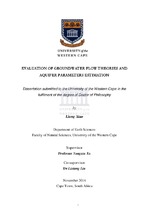| dc.description.abstract | This thesis deals with some fundamental aspects of groundwater models. Deterministic mathematical models of groundwater are usually used to simulate flow and transport processes in aquifer systems by means of partial differential equations. Analytical solutions for the deterministic mathematical models of the Theis problem and the transient confined-unconfined flow in a confined aquifer are investigated in the thesis. The Theis equation is a most commonly applied solution for the deterministic mathematical model of the Theis problem. In the thesis, a most simplified similarity transformation method for derivation of the Theis equation is proposed by using the Boltzmann transform. To investigate the transient confined-unconfined flow towards a fully penetrating well in a confined aquifer, a new analytical solution for the deterministic mathematical models of interest is proposed in the thesis. The proposed analytical solution considers a change of hydraulic properties (transmissivity and storativity) during the confined-unconfined conversion. Based on the proposed analytical solution, a practical method to determine distance of the conversion interface from pumping well and diffusivity of the unconfined region is developed by using a constant rate test. Applicability of the proposed analytical solution is demonstrated by a comparison with previous solutions, namely the MP and the Chen models. The results show that the proposed analytical solution can be used to assess the effect of the change of diffusivity on the transient confined-unconfined flow. The MP model is only accepted if the transmissivity during the confined-unconfined conversion is constant. The Chen model, given as a special case of the proposed analytical solution, is limited to the analysis of the transient confined-unconfined flow with a fixed diffusivity. An important application of groundwater models is to estimate parameters, such as hydraulic properties and flow dynamics, of groundwater systems by assessing and analysing field data. For instance, the pumping and the hydrochemistry and environmental tracer tests are two effective ways to obtain such data. To evaluate hydraulic properties of aquifer systems by derivative interpretation of drawdown data from pumping tests, a new diagnostic analysis method is proposed based on a lg-lg drawdown derivative, dlgs/dlgt, and the differentiation algorithm namely Lagrange Interpolation Regression (LIR) in the thesis. Use of a combined plot of dlgs/dlgt and a semi-lg drawdown derivative (ds/dlgt) is made to identify various flow segments during variable discharge tests with infinite conditions, constant rate tests in bounded aquifers and tests involving double-porosity behaviours. These can be applied to further characterize pumped aquifers. Compared to traditional diagnostic analysis method using plot of ds/dlgt alone, the combined drawdown derivative plot possesses certain advantages identified as: (1) the plot of dlgs/dlgt is strikingly sensitive for use in unveiling differences between pumping and its following recovery periods in intermittent variable discharge tests; (2) storativity (S) of pumped aquifers can be evaluated by using the combined plot; and (3) quantitative assessments of double-porosity behaviours can also be achieved. Based on two case studies, advantages and disadvantages of uses of the LIR and other existing differentiation methods in calculations of numerical drawdown derivative are demonstrated in practice. The results suggest that the LIR is a preferred method for numerical differentiation of drawdown data as it can be used to effectively minimise noisy effects. The proposed derivative approach provides hydrologists with an additional tool for characterizing pumped aquifers. Use of hydrochemistry and environmental tracer tests to assess flow dynamics of groundwater systems is demonstrated via a case study in the dolomite aquifer of South Africa. An emphasis is on determining mean residence times (MRTs) of the dolomite aquifer by means of an appropriate box model with time series of 14C values of dissolved inorganic carbon (14C-DIC) and initial 14C activities of spring samples during 1970s and 2010s. To obtain the calibrated 14C MRTs, 13C values of dissolved inorganic carbon (δ13C-DIC) of the spring samples are applied to estimate mineral dissolution in the dolomite aquifer and calculate the initial 14C activities. The results indicate that the spring samples have about 50%-80% initial 14C activities. By using the appropriate box model, the calibrated 14C MRTs of the spring system are given within a range from ≤ 10 to 50 years. Additionally, the flow dynamics, including the recharge source and area, the effect of climate change on the temporal trend of the groundwater MRTs and the groundwater flow circulation, of the dolomitic spring system are also discussed for further possible management interventions in the dolomite aquifer. | en_US |

